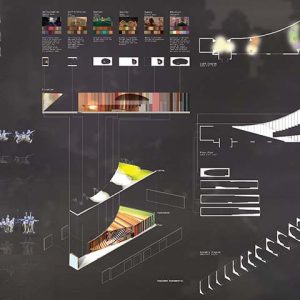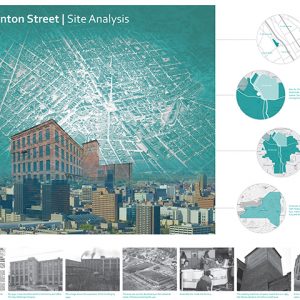Immersed in a broad and transdisciplinary educational setting, students challenge and rethink the built environment by promoting positive change through design in a continually evolving global context.
Admission + Portfolio Requirements
Our environmental and interior design (EDI) program develops curious and critical thinkers who pursue diverse career paths. It was ranked among the “Most Admired Interior Design Schools” by leaders and hiring managers in DesignIntelligence. and recognized as one of “17 Interior Design Schools Worth Applying to” by Architectural Digest.
Through the exploration of the art and architecture of environmental design, students solve problems in a broad range of built environments. Students work closely with faculty in a studio environment similar to the professional design office experience. The curriculum and projects support the professional, multidisciplinary philosophy and foster the creation of humane, sustainable environments for people. Visualization and communications skills, as well as a strong technical component, provide a basis for the education of designers who will become creative problem solvers and leaders in various fields of interior design.
Students receive a broad liberal arts education in conjunction with studio courses in fine arts to complement their work in environmental and interior design. A sensitivity to the concerns of people, sustainable design practices and an understanding of the business of design contribute to their overall competence. Individual work experiences and actual and collaborative projects in the community and with industry expose students to current and future issues.
The program shares courses, design laboratories, and studios with other disciplines in the School of Design maintains a close relationship with professional designers, design societies, and manufacturers. Students and the program have received many national and international design awards.
Students are encouraged to spend a semester abroad in their junior year at Syracuse University’s Design in London program; to collaborate on special projects; and to pursue internships in Syracuse, New York City, across the continent, and around the globe.
Highly Desired Program
Our program is ranked in most top 10 rankings for interior design! See for yourself:
M.A.“+1” Degree in Design
Did you know that School of Design B.F.A. and B.S. students can earn a master of arts (M.A.) in design in only one additional year? You apply for the program in your junior year and take two graduate-level classes in your senior year. You then participate in a short summer “bootcamp” and finish the M.A. in just one year after earning your undergraduate degree. Learn more about the M.A. in design.
Student Work
Program Mission, Goals, and Student Achievement
The EDI program develops curious and critical thinkers who pursue diverse career paths. Immersed in a broad and transdisciplinary educational setting, students thoughtfully engage, challenge, and rethink the built environment by promoting positive change through design in a continually evolving global context.
The EDI program endeavors to teach students how to become creative problem-solvers and critical thinkers who excel in environmental design by fostering:
- an openness to new ideas and the ability to question the status quo
- an understanding that learning is the essential component in problem-solving and a way of life
- an acknowledgement of the historical, cultural, contextual, psychological, and behavioral impacts of design
- an awareness of social responsibility, building stewardship, multicultural diversity, and ecology
- an embrace of advanced visual communication skills for conceptualizing, articulating, describing, and actualizing design projects
Curriculum
Below are the general program requirements for the B.F.A. degree in environmental and interior design.
View official major requirements.
Major requirements: 54 credits
Art history requirements: 15 credits
Academic requirements: 6 credits
Liberal Arts and Sciences Electives: 12
Academic electives: 11 credits
Studio electives: 21 credits
First year seminar: 1 credit
Total Credits 120
Accreditation
The environmental and interior design program leading to the bachelor of fine arts (B.F.A.) degree is accredited by the Council for Interior Design Accreditation (CIDA), www.accredit-id.org, 206 Grandville Avenue, Suite 350, Grand Rapids, MI, 49503.
The CIDA-accredited program prepares students for entry-level interior design practice, for advanced study, and to apply for membership in professional interior design organizations. The B.F.A. granted by Syracuse University meets the educational requirements for eligibility to sit for the National Council for Interior Design Qualification Examination (NCIDQ Exam). For more information about NCIDQ Exam eligibility visit www.cidq.org/eligibility-requirements.












